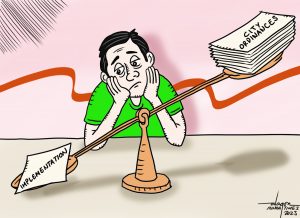So Davao City also recently had its own new logo launch, which seems to be the trend in the Philippines these days. Yes, we have a new Kadayawan Festival logo. Again.
I have lost track of the number of times the festival has changed its logo as well as the reasons for the changes.
With the logo are the words (like movie subtitles): “Colors of Abundance / Vibrance of Diversity / Festival of Festivals.”
I am not a professional visual artist so maybe I am not a good judge of what makes a good logo. However, I am a communicator. And what this new Kadayawan logo communicates to me is a Moroccan plate. Or some type of spinning wheel. It looks too busy to be a logo and from an economics point of view, it looks too expensive to print out.
I am not bashing the logo. It looks nice. But does it easily communicate the message of Kadayawan?
What even is the point of Kadayawan? To understand what it means, we have to know the festival’s history.
We are all familiar with the story of how Kadayawan came from the Apo Duwaling Festival started under then Acting Davao City Mayor Zafiro Respicio in 1986 and renamed to Kadayawan Festival by then newly elected Mayor Rodrigo R. Duterte in 1988.
But where did the idea of the Apo Duwaling celebration come from? It is actually inspired by the Obo Manobo tribe’s Kalibongan Festival in Kidapawan City in the 1970s. It was started by the Mindanao Highlanders Association, Inc. and was introduced to the late Mayor Respicio, who reinvented it for the Davao context as Apo Duwaling to represent Davao City’s icons – Mt. Apo. Durian, and Waling-Waling. It was a way to unify the diverse population of Davao while the city was recovering from the violence of the martial law period. It was also an attempt to lure visitors to Davao and rehabilitate its image as “killing fields of Asia.”
The tourism value is only secondary, though. The festival has always been rooted in indigenous communities and their struggle for land and self-determination. Thanksgiving and deep connection to nature are inherent parts of any indigenous celebration. But as they give thanks, they also lament their current state of being marginalized.
Recent festival celebrations have rebranded Kadayawan to appeal to a younger demographic with its “11 tribes, one vibe” catch phrase. I assume that is the current version of the old “unity in diversity.” But what does having “one vibe” even mean? And what kind of vibe is that? Does it include solidarity with the indigenous peoples’ struggle?
Mayor Sebastian Z. Duterte, in his message read by Vice-Mayor J Melchor Quitain during the media launch, said the festival is “the time of the year where we honor the 11 ethnolinguistic tribes of Davao City and celebrate the abundance of the city’s natural resources.”
Mayor Baste, in the same message, urged us to “embrace and remember that it is our mutual respect for the uniqueness of our respective customs and traditions that binds us all as one Dabawenyo community.”
And there it is —COMMUNITY. This is what I have been missing from our Kadayawan celebrations in recent years — this sense of community. Lately, I feel like a mere spectator rather than an actual participant in a community celebration.
In their article featured on Stanford Social Innovation Review, “What is Community Anyway?”, David Chavis and Kien Lee wrote: “Community is both a feeling and a set of relationships among people…That treasured feeling of community comes from shared experiences and a sense of — not necessarily the actual experience of — shared history. As a result, people know who is and isn’t part of their community. This feeling is fundamental to human existence.”
The word Kadayawan comes from the Mandaya word “Madayaw” which refers to anything of high value or something treasured. So it is also a celebration of our cherished values as a community.
Do we value our curated public image for our visitors more or the sense of community of our diverse peoples? Is the celebration exploiting or empowering?
When we design our Kadayawan Festival primarily as a tourism event and our rich cultural heritage as “tourist attractions” organized by event organizers who do that for a living, we create a disconnect from our indigenous communities.
For one, our “Indak-Indak” recently is essentially performed on stage facing the judges and the VIPs, not an actual street dancing where the community can join in and dance with the performers.
Perhaps our Kadayawan has already evolved for a new generation of consumers and it is now too late to go back to its indigenous roots.
But I would like to experience a festival where the indigenous communities have the actual ownership and control of the celebration and we are their guests in solidarity. It must be a true community that is real everyday and not just when visitors are watching. After all, it is their land. We are just living in it and living off of it.
(Patmei Bello Ruivivar – A columnist since she’s 8 years old. She is the President of Kahayag Foundation, Vice-President of the Davao Historical Society, Vice-President of the Rotary Club of Downtown Davao, and Vice-Chair of the Golden Unicorn Savings and Credit Cooperative.)

